
Onward was an early steamboat on the Willamette River built at Canemah, Oregon in 1858. This vessel should not be confused other steamboats named Onward, including in particular the Onward of 1867, a similar but somewhat smaller vessel built at Tualatin Landing, which operated on the Tualatin River under Capt. Joseph Kellogg.

Echo was a sternwheel steamboat that operated on the Willamette River from about 1865 to 1873 and was one of the first steamboats to carry what was then considered a large cargo out of Eugene, Oregon.
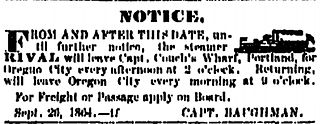
Rival was a sternwheel steamboat that ran on the Willamette River between Oregon City and Portland, Oregon from 1860 to 1868. Rival was intended to be a boat which would promise low fares in an effort to beat a steamboat monopoly which was then in formation.
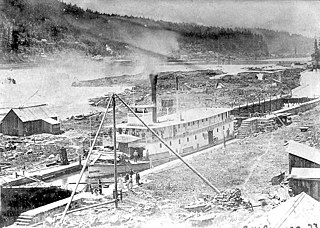
Governor Grover was a sternwheel steamboat that ran on the Willamette River during the 1870s. Because of the completion of the Willamette Locks in late 1872, it was possible for vessels such as Governor Grover to be built in Portland, Oregon and then readily navigate the Willamette above Willamette Falls.
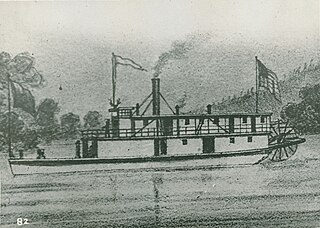
Elk was a stern-wheel driven steamboat built on the Willamette River in 1857 at Canemah, Oregon. This steamboat is chiefly remembered for its destruction by a boiler explosion in which by good fortune no one was seriously hurt. A folklore tale later arose about this disaster.

The People's Transportation Company operated steamboats on the Willamette River and its tributaries, the Yamhill and Tualatin rivers, in the State of Oregon from 1862 to 1871. For a brief time this company operated steamers on the Columbia River, and for about two months in 1864, the company operated a small steamer on the Clackamas River.

Shoo Fly was a sternwheel-driven steamboat that operated on the Willamette and Columbia rivers in the 1870s. Originally built as primarily a freight boat, the vessel was used in other roles, including towing and clearing of snags. Shoo Fly inspired the name of another sternwheeler on the Willamette River, Don't Bother Me.

The Upper Willamette Transportation Line was a line of four inland steamboats that operated from the fall of 1859 to the summer of 1860 on the upper Willamette River in the state of Oregon, United States.

Enterprise was a sternwheel steamboat that operated on the Willamette River from 1863 to 1875. This vessel should not be confused with several other steamers named Enterprise which operated in the Pacific Northwest at about the some time.
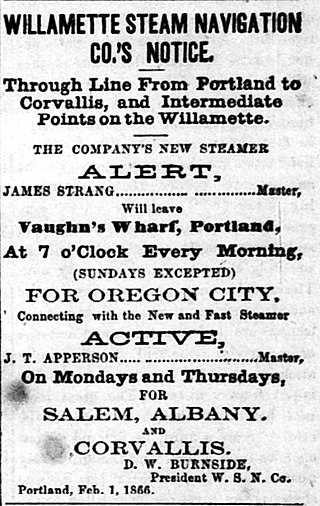
Alert was a sternwheeler steamboat which operated on the Willamette River, in Oregon, United States, from 1865 to 1875. Originally built for and owned by the Willamette Steam Navigation Co., it was soon acquired by the People's Transportation Company, a steamboat line which held a near-monopoly on Willamette River transportation. This vessel was rebuilt in 1871, and ran until 1875, when it was dismantled.

James Clinton was a steamboat which operated on the upper Willamette River from 1856 to 1861. Although the Clinton was said to have been "not a very good boat.", it was the first steamer ever to reach Eugene, Oregon. James Clinton was destroyed in April 1861, when a large fire broke out at Linn City, Oregon in a shoreside structure near to where the vessel was moored.

Oregon was a side-wheel driven steamboat that operated on the Willamette River in the state of Oregon from 1852 to 1854. The steamer was not economically successful and became a total loss by sinking after a short career.

Minnehaha was a sternwheel-driven steamboat which was built in 1866 on Oswego Lake, then known as Sucker Lake, in Oregon, United States. Minnehaha was later transferred to the Willamette and Columbia rivers where it operated for the first part of the 1870s.

Dayton was a steamboat which operated on the Willamette and Columbia rivers from 1868 to 1881. Dayton operated on the Willamette from 1868 to 1876, mostly upriver from Willamette Falls, including a route on the Yamhill River to Dayton, Oregon, after which the steamer was named. From 1876 to 1881, Dayton was employed on a run from Portland to Monticello, W.T., which was located on the site of what is now Longview, Washington.

Albany was a stern-wheel driven steamboat that operated on the Willamette River from 1868 to 1875. This vessel should not be confused with the later sternwheeler Albany, which ran, also on the Willamette River, from 1896 to 1906, when it was rebuilt and renamed Georgie Burton.

Occident was a steamer that operated on the Willamette River and occasionally its tributary, the Santiam River from 1875 to about 1890. Occident was designed primarily for freight work, and did not have passenger accommodations. This Occident should not be confused with the smaller steam launch Occident, apparently propeller-driven, which operated out of Astoria, Oregon in the 1890s.

Relief was a stern-wheel driven steamboat that operated on the Willamette River from 1858 to 1865. Relief ran for a short time on the route from Portland to Oregon City, Oregon. After being bought out by the competition, Relief was lined around Willamette Falls to the upper Willamette, where it became the first steamboat to reach Springfield. This vessel should not be confused with a later vessel, also named Relief, which operated on the Columbia and Lewis rivers from 1906 to 1931.

Active was a stern-wheel driven steamboat that operated on the upper Willamette River from 1865 to 1872. During its short operational life, Active was owned by several different steamboat companies. It was dismantled in 1872 at Canemah, Oregon.
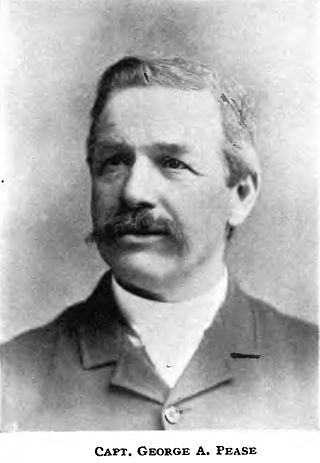
George Anson Pease was a steamboat captain in the Pacific Northwest region on the United States, who was active from the earliest days of steamboat navigation on the Willamette River in the 1850s. He worked in various roles until the early 1900s, commanding numerous vessels during that time. During a flood in 1861, while in command of the sternwheeler Onward, Pease rescued 40 people from a flood in the area of Salem, Oregon.

Surprise was a steamboat which operated on the upper Willamette River from 1857 to 1864.

















